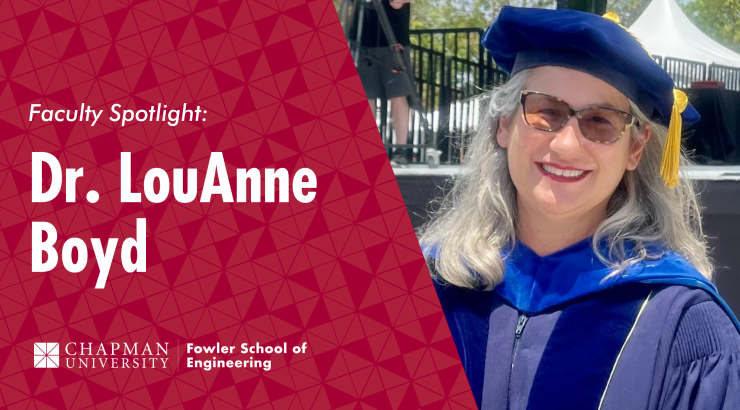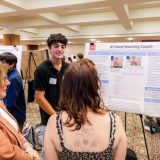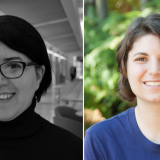
Chapman Engineering Faculty Innovates With Empathy to Expand Neurodiversity Research Honoring Dr. LouAnne Boyd’s bold research transition to support autism inclusion
July 7, 2023

In April 2023, Boyd traveled to Germany to present her user-centric approach to assistive technologies at the CHI Conference on Human Factors in Computing Systems.
To a researcher, taking the steps toward completely reimagining one’s research framework could be a challenging, thrilling, and potentially daunting endeavor. However, for Dr. LouAnne Boyd—an Assistant Professor at Fowler School of Engineering (FSE)—this is not only a welcome decision to follow the path she feels most passionate about. It also provides her with new research opportunities that can open doors for neurodiverse people and advocates across a variety of fields.
Over the past twenty-five years, autism research has thrived at the very heart of Boyd’s dedicated studies. Throughout her career, she has concentrated on building sensor-based technologies that facilitate nonverbal communication on an individual level, making environments sensorily comfortable, and helping neurodiverse people navigate the normative world. Boyd has recently begun to enter a transitional period in this research area, taking a bold leap into new territory aimed at creating a more accepting, understanding, and ever-growing worldview of neurodiversity.
“In this journey of being a professor, I’ve learned to take my work deeper and get feedback,” said Boyd. “The world has opened up so much in the last couple of decades; there are scholars in my field now who are autistic and their voices are getting represented at an academic level … and so I’ve been really reflecting on that. Now my work is shifting—I’m going to be working on technologies that support reducing stigma around autism.”
Boyd partially owes this change to her time in academia. Prior to earning her Ph.D in Informatics from the University of California, Irvine (UCI), she worked within school districts to help neurodiverse students succeed by boosting access opportunities. Here at Chapman, many of her experiences have involved working alongside neurodiverse groups to honor unique perspectives and learning approaches—including in her own courses in human computer interaction.

Boyd and her students Drew Bozarth (Software Engineering, ’24) and Daniel Dinh (Software Engineering, ’24) in the data analysis stage of research during their lab period.
“My research is about diversity, equity, and inclusion, specifically around neurodiversity. Anywhere from 10 to 20 percent of the world is neurodiverse and I am working with neurodiverse people in my classes. I practice what I preach in the sense that I want to be a teacher who makes information accessible in the most varied ways while also reaching every student to ensure nobody feels left out; learning is for everybody. I most enjoy supporting learning and engaging with learning processes—it’s really rewarding, exciting, and a challenge that never ends,” Boyd shared. “I feel grateful to be where I am, to be working with students who are open, know they can explore their passions, and know that they have support from professors who are going to understand and hear them. That’s just such a gift.”
For Boyd, this change prioritizes balance: while developing assistive technology to help mediate social interactions is vital, it is also necessary to simultaneously tackle social information, such as common stigmas that affect people with autism. In doing so, Boyd believes that researchers can use their work to better celebrate neurodiverse communities.
“My work is going to help accommodate differences that are interpreted as deficits in autism and will focus on celebrating these differences with a hybrid model,” said Boyd. “If someone is working on clinical skills from a user-centered perspective, that’s good and still needs to happen, but we also have to course correct and go beyond to get at stigma, too. Why do we make such a big deal that people behave differently? Difference is not a scary thing; in fact, there’s a lot of beauty and richness to celebrate. We can change the way people see autism.”

Throughout the writing process, Boyd developed a variety of charts and diagrams designed to help readers understand her core concepts through a variety of means. Here, the diagram on her screen promotes a sensory-first approach within her paradigm-shifting sensory framework.
Recently, Boyd finished writing a book that addresses these issues through key diagrams and professional interactions with neurodiverse scholars that reflect her own ever-changing journey within neurodiversity research. Once published, she hopes that this text can help researchers better understand what it means to embrace a wider variety of perspectives from all across the field. “I’ve been thinking really deeply about what exists to create a hybrid model. We’ve previously had a model that was very clinical, focused on what I call the ‘sensory accommodation framework’—if you’re a speech therapist, you’d work on speech skills; if you’re an occupation therapist, you’re also in your own little box,” explained Boyd. “How do I use my unique experiences to pull these fields together? It requires tying together multiple different clinical backgrounds like neurology all the way up to the special ed teacher.”
Boyd expressed excitement in the face of this challenge, feeling uniquely positioned to approach this exact paradigm shift. In the future, she aims to accomplish these goals by weaving together the work of both autism advocates and experienced clinicians. This can help ensure that researchers in her field are not only providing access opportunities on an individual level but are also tackling the large-scale stigmas that impact the greater community—both of which, Boyd shared, must go hand-in-hand for neurodiversity research efforts to thrive.
“I’m here to build a bridge between these communities—that is my unique calling. I get to take in all of this literature in these spaces, see what’s missing, and follow my own intellectual curiosities,” said Boyd. “Somebody has to build: somebody has to take that fire [of critical disability studies], be burned to the ground, and then rise up again to create something new.”
Those interested in learning more about Boyd’s pre-existing work or following her future research endeavors are encouraged to check out her official Chapman faculty profile.

